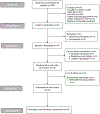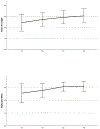Improving sleep apnea treatment adherence after traumatic brain injury: A nonrandomized feasibility study
- PMID: 36355639
- PMCID: PMC10166197
- DOI: 10.1037/rep0000473
Improving sleep apnea treatment adherence after traumatic brain injury: A nonrandomized feasibility study
Abstract
Purpose/objective: To evaluate the feasibility of a psychological intervention designed to increase Positive Airway Pressure (PAP) adherence, adapted with cognitive accommodations for comorbid obstructive sleep apnea (OSA) and traumatic brain injury (TBI).
Research method/design: This was an open-label single arm (nonrandomized) study. Eligibility criteria were moderate-to-severe TBI, OSA diagnosis, prescribed PAP, nonadherent, and able to consent. Participants were recruited from inpatient and outpatient settings at a tertiary care hospital. The four-module manualized intervention was delivered primarily via telehealth. Feasibility aspects measured included eligibility, recruitment, and retention rates; session duration and attendance; and characteristics of outcome and process measures (e.g., completion rates, data distribution). Symptom measures included the Epworth Sleepiness Scale, Fatigue Severity Scale, Functional Outcomes of Sleep Questionnaire, Self-Efficacy Measure for Sleep Apnea, OSA Treatment Barriers Questionnaire (OTBQ), and Kim Alliance Scale-Revised.
Results: Of 230 persons screened, 14.3% were eligible. Recruitment rate (n = 17) was 51.5%. Retention rate (n = 13) was 76.5%. Treatment completers had no missing data. The OTBQ deviated from normality, but other measures had adequate skew (< 2.0) and kurtosis (< 7.0) and were free from significant floor and ceiling effects (<15%). Change score effect sizes were minimal to moderate (d = .10-.77). There were no adverse events.
Conclusions/implications: These results inform ways in which procedures should be modified to enhance the success of a future clinical trial testing the efficacy of this adherence intervention. Inclusion criteria should be reconsidered, and recruitment sites expanded, to capture eligible persons and adequately power an efficacy study. (PsycInfo Database Record (c) 2022 APA, all rights reserved).
Trial registration: ClinicalTrials.gov NCT04221009.
Conflict of interest statement
Dr. Aloia was employed by Philips, Inc during this study and is a company stockholder. The authors declare no other conflicts of interest.
Figures



Similar articles
-
Hypoglossal Nerve Stimulation: Outcomes in Veterans with Obstructive Sleep Apnea and Common Comorbid Post-traumatic Stress Disorder.Laryngoscope. 2021 Mar;131 Suppl 3:S1-S11. doi: 10.1002/lary.29292. Epub 2020 Dec 9. Laryngoscope. 2021. PMID: 33295673
-
Incidence and predictors of adherence to sleep apnea treatment in rehabilitation inpatients with acquired brain injury.Sleep Med. 2020 May;69:159-167. doi: 10.1016/j.sleep.2020.01.016. Epub 2020 Jan 25. Sleep Med. 2020. PMID: 32088352
-
The impact of a telemedicine monitoring system on positive airway pressure adherence in patients with obstructive sleep apnea: a randomized controlled trial.Sleep. 2012 Apr 1;35(4):477-81. doi: 10.5665/sleep.1728. Sleep. 2012. PMID: 22467985 Free PMC article. Clinical Trial.
-
Nursing Interventions Improve Continuous Positive Airway Pressure Adherence in Obstructive Sleep Apnea With Excessive Daytime Sleepiness: A Systematic Review.Rehabil Nurs. 2020 May/Jun;45(3):140-146. doi: 10.1097/rnj.0000000000000190. Rehabil Nurs. 2020. PMID: 30461507
-
Positive airway pressure in pediatric obstructive sleep apnea.Paediatr Respir Rev. 2019 Aug;31:43-51. doi: 10.1016/j.prrv.2019.04.006. Epub 2019 Apr 27. Paediatr Respir Rev. 2019. PMID: 31130426 Review.
References
-
- Bogner JA, Whiteneck GG, MacDonald J, Juengst SB, Brown AW, Philippus AM, … & Corrigan JD. (2017). Test-retest reliability of traumatic brain injury outcome measures: a traumatic brain injury model systems study. Journal of head trauma rehabilitation, 32(5), E1–E16. doi: 10.1097/HTR.0000000000000291 - DOI - PubMed
-
- Craske MG (2017). Cognitive behavior therapy (2nd ed.). Washington, DC: American Psychological Association.
-
- Creswell JW (2014). A concise introduction to mixed methods research. Thousand Oaks, CA: SAGE publications.
MeSH terms
Associated data
Grants and funding
LinkOut - more resources
Full Text Sources
Medical
Research Materials

